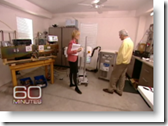 The M.D. Anderson Cancer Center in Houston and the University of Pittsburgh both have the machine and are doing some additional testing. Mr. Kanzius was not from the medical field and somewhat stumbled up on his creation, being a person suffering from cancer as well. This is a recent story done by 60 Minutes.
The M.D. Anderson Cancer Center in Houston and the University of Pittsburgh both have the machine and are doing some additional testing. Mr. Kanzius was not from the medical field and somewhat stumbled up on his creation, being a person suffering from cancer as well. This is a recent story done by 60 Minutes.
Now adding nanno particles to the process is showing how to target and find the cancer cells. A Nobel Prize winner, skeptic and thinking nothing would result made the donations. The process is harmless using radio waves and "cooks" the cancer, some tests have started with animals. The nanno cells adhere to the cancel cells, not normal cells and this is what cooks the cancer cells with the radio wave technology. It is almost something out of  science fiction, but one more potential step forward in the cure for cancer. If this works, many drug companies might be on a whole new path for R and D. John Kanzius may not live long enough though to see it through, which is sad.
science fiction, but one more potential step forward in the cure for cancer. If this works, many drug companies might be on a whole new path for R and D. John Kanzius may not live long enough though to see it through, which is sad.
Watch the video and form your own opinion. The story was very well done and if the R and D can turn this in to a success, it could save the lives of millions. The film stated it was about 4 years away from the potential of being tried on a human. BD
What if we told you that a guy with no background in science or medicine - not even a college degree - has come up with what may be one of the most promising breakthroughs in cancer research in years? Well it's true, and if you think it sounds improbable, consider this: he did it with his wife's pie pans and hot dogs.
Here's how it works: one box sends radio waves over to the other, creating enough energy to activate gas in a fluorescent light. Kanzius put his hand in the field to demonstrate that radio waves are harmless to humans.



The devil, as they say, is in the details. What we need in oncology is not a new way to cook the cancer cells--we've got that, thanks much, in chemotherapy, RF ablation, radiation treatment, and other technologies.
ReplyDeleteThe issue is targeting. How do you treat only the cancer cells while avoiding the rest of the body? "Inject the tumor with the nanoparticles" is the trivial answer, and that's helpful to a point. But people don't die of individual tumors, and that's not why we give them chemotherapy. The problem is that frequently cancer is a systemic disease.
We know tumor cells circulate in the bloodstream; there are FDA tests to measure this.
So, Mr. Kanzius, can you design for us a system that selectively targets only the cancer cells, completely sparing the rest of the organism?
You get a sense of this problem in the name of the prostate cancer screening molecule: PSA stands for prostate cancer specific antigen. The name reflects the hope that the relevant scientists actually discovered the specific molecule that marks prostate cancer. As we know, there are huge specificity (false-positive) problems with PSA testing.
The exciting developments in cancer treatment, then, are in targeting. Rituximab is a huge success because it is a CD20 monoclonal--selectively targets lymphoma cells. Herceptin--terrific drug. Monoclonal. Targets a protein on the outside of some breast cancer cells. Gleevec--revolutionized the treatment of leukemia, and turned a disease with a 30% cure rate after stem cell transplant to one with a 97% cure rate after taking some pills. Huge. Our most successful drugs are the ones that have the best risk-benefit profile. All drugs are effective at high enough doses; problem is they also get really toxic at highest doses.
I propose, therefore, that the Kanzius Machine is an interesting side note on the main path of oncology. While it has captured the imagination of the press and public, it is a hammer in search of a nail. Can these nanoparticles be conjugated to a monoclonal? What target will the monoclonal select? These are the real unanswered questions in medical oncology, though we continue to make progress on them.
I know of something that in theory kills only kills cancer cells, but not normal cells. It's flavonoids. Take a look at this:
ReplyDeletehttp://www.treat-cancer.nl/
There are a lot of things, Steven, that kill only cancer cells in theory. Seems like everyone's got a pet theory about how to kill a cancer cell, and if you don't have one, there are journals chock full of what we call "preclinical" research about cancer cell killing.
ReplyDeleteIt's not so easy to kill a cancer cell in a person. Toxicity is a real problem, as is bioavailability and a lot of other boring pharmacological issues. This is the reason why, historically, only about 1-5% of all agents tested in Phase I make it to FDA approval.
Still, we try. I urge anyone with an "idea" about how to kill a cancer cell to organize a clinical trial around their idea, or write a grant to get Federal money to do so. At last check, NIH dispersed $11 billion per year, much of it for clinical research.
We only have to think of the recent example of Airbourne, which was found to have no effect on clinical testing, now the subject of a class-action lawsuit.
InteractMD.com